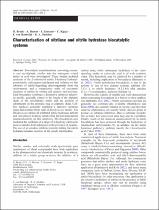JavaScript is disabled for your browser. Some features of this site may not work without it.
- ResearchSpace
- →
- Research Publications/Outputs
- →
- Journal Articles
- →
- View Item
| dc.contributor.author |
Brady, D

|
en_US |
| dc.contributor.author |
Beeton, A

|
en_US |
| dc.contributor.author |
Zeevaart, J

|
en_US |
| dc.contributor.author |
Kgaje, C

|
en_US |
| dc.contributor.author |
Van Rantwijk, F

|
en_US |
| dc.contributor.author |
Sheldon, RA

|
en_US |
| dc.date.accessioned | 2007-01-12T10:14:20Z | en_US |
| dc.date.accessioned | 2007-06-07T10:03:11Z | |
| dc.date.available | 2007-01-12T10:14:20Z | en_US |
| dc.date.available | 2007-06-07T10:03:11Z | |
| dc.date.issued | 2004-03 | en_US |
| dc.identifier.citation | Brady, D, et al. 2004. Characterisation of nitrilase and nitrile hydratase biocatalytic systems. Applied Microbiology and Biotechnology, vol 64(1), pp 76 -85. | en_US |
| dc.identifier.issn | 0175-7598 | en_US |
| dc.identifier.uri | http://hdl.handle.net/10204/1390 | en_US |
| dc.identifier.uri | http://hdl.handle.net/10204/1390 | |
| dc.description.abstract | Bio-catalytic transformations converting aromatic and arylaliphatic nitriles into the analogous related amide or acid were investigated.These studies included synthesis of the beta-substituted nitrile 3-hydroxy-3-phenylpropionitrile, subsequent enrichment and isolation on this substrate of nitrite-degrading micro-organisms from the environment, and a comparative study of enzymatic reactions of nitriles by resting cell cultures and enzymes. Each biocatalyst exhibited a distinctive substrate selectivity profile, generally related to the length of the aliphatic chain of the arylaliphatic nitrile and the position of substituents on the aromatic ring or aliphatic chain. Cell-free nitrilases generally exhibited a narrower substrate range than resting whole cells of Rhodococcus strains. The Rhodococcus strains all exhibited nitrile hydratase activity and converted beta-hydroxy nitriles (but did not demonstrate enantioselectivity on this substrate). The biocatalysts also mediated the synthesis of a range of alpha-hydroxy carboxylic acids or amides from aldehydes in the presence of cyanide. The use of an amidase inhibitor permits halting the nitrile hydratase/amidase reaction at the amide intermediate. | en_US |
| dc.format.extent | 122557 bytes | en_US |
| dc.format.mimetype | application/pdf | en_US |
| dc.language.iso | en | en_US |
| dc.publisher | Springer-Verlag | en_US |
| dc.rights | Copyright : 2004 Springer-Verlag | en_US |
| dc.subject | Bio-catalysts | en_US |
| dc.subject | Biotechnology | en_US |
| dc.subject | Applied microbiology | en_US |
| dc.subject | Rhodococcus strains | en_US |
| dc.subject | Nitriles | en_US |
| dc.subject | Carboxylic acids | en_US |
| dc.subject | Amides | en_US |
| dc.title | Characterisation of nitrilase and nitrile hydratase biocatalytic systems | en_US |
| dc.type | Article | en_US |
| dc.identifier.apacitation | Brady, D., Beeton, A., Zeevaart, J., Kgaje, C., Van Rantwijk, F., & Sheldon, R. (2004). Characterisation of nitrilase and nitrile hydratase biocatalytic systems. http://hdl.handle.net/10204/1390 | en_ZA |
| dc.identifier.chicagocitation | Brady, D, A Beeton, J Zeevaart, C Kgaje, F Van Rantwijk, and RA Sheldon "Characterisation of nitrilase and nitrile hydratase biocatalytic systems." (2004) http://hdl.handle.net/10204/1390 | en_ZA |
| dc.identifier.vancouvercitation | Brady D, Beeton A, Zeevaart J, Kgaje C, Van Rantwijk F, Sheldon R. Characterisation of nitrilase and nitrile hydratase biocatalytic systems. 2004; http://hdl.handle.net/10204/1390. | en_ZA |
| dc.identifier.ris | TY - Article AU - Brady, D AU - Beeton, A AU - Zeevaart, J AU - Kgaje, C AU - Van Rantwijk, F AU - Sheldon, RA AB - Bio-catalytic transformations converting aromatic and arylaliphatic nitriles into the analogous related amide or acid were investigated.These studies included synthesis of the beta-substituted nitrile 3-hydroxy-3-phenylpropionitrile, subsequent enrichment and isolation on this substrate of nitrite-degrading micro-organisms from the environment, and a comparative study of enzymatic reactions of nitriles by resting cell cultures and enzymes. Each biocatalyst exhibited a distinctive substrate selectivity profile, generally related to the length of the aliphatic chain of the arylaliphatic nitrile and the position of substituents on the aromatic ring or aliphatic chain. Cell-free nitrilases generally exhibited a narrower substrate range than resting whole cells of Rhodococcus strains. The Rhodococcus strains all exhibited nitrile hydratase activity and converted beta-hydroxy nitriles (but did not demonstrate enantioselectivity on this substrate). The biocatalysts also mediated the synthesis of a range of alpha-hydroxy carboxylic acids or amides from aldehydes in the presence of cyanide. The use of an amidase inhibitor permits halting the nitrile hydratase/amidase reaction at the amide intermediate. DA - 2004-03 DB - ResearchSpace DP - CSIR KW - Bio-catalysts KW - Biotechnology KW - Applied microbiology KW - Rhodococcus strains KW - Nitriles KW - Carboxylic acids KW - Amides LK - https://researchspace.csir.co.za PY - 2004 SM - 0175-7598 T1 - Characterisation of nitrilase and nitrile hydratase biocatalytic systems TI - Characterisation of nitrilase and nitrile hydratase biocatalytic systems UR - http://hdl.handle.net/10204/1390 ER - | en_ZA |






